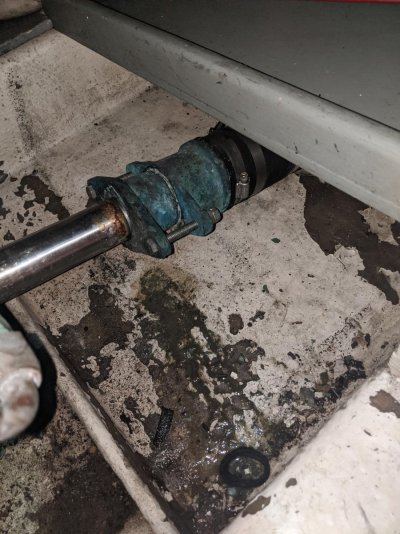I'm another who has done the repacking a number of times starting long before the internet was even around. I found the water inflow was not great and the BP easily kept up. Other than the available books I was on my own as there is room in there for one person at a time.
I made a couple picks to dig out the old packing and then found corkscrew type tools for this purpose are available at the chandleries. May have to be ordered.
https://www.jamestowndistributors.com/userportal/show_product.do?pid=3861
Actually any good seal shop, Orings and packings, will have these things also.
I used razor blades to cut the packing into rings by wrapping a piece around the shaft using the part of shaft that was NOT in the stuffing box. They are sharp so be carefull. A very sharp utility knife such as the Olfa with a new blade will do well also. You don't need to press hard to get the stuff to cut. Even better would be approaching a prop/shaft shop and seeing if a short piece of shafting of your size can be had and then used as an arbor to cut them at home.
Cut the ends on an angle such as 45o. The angle does not need to be exact, just so the angle closes [mostly] as the ring is wrapped around the shaft.
Tamping with screwdrivers will likely punch a hole through the packing. It will close later as the box is tightened but better to not damage it.
Install the ring and use a tamping tool made of PVC pipe cut in 1/4's .
I made the tampers ahead of time. They only need to be 1/4 the shaft circumference and push gently working the ring into place. Then place the second and third rings repeating the tamping.
I used to install 4 or 5 rings but found it was not needed and actually made adjusting more difficult.
Install 3 rings [or a 4th] with the ends arranged approx 120o from each other so the ends do not line up , ring to ring.
Then install the stuffing box compression ring and tighten the nuts up EVENLY a bit at a time. DO not just screw one side down and then the other. The packing needs to be compressed evenly.
I would grease the stud and nut threads with water resistant grease. Outboard shaft grease is great at this but others are available.
Adjust so the water stops. Then run the engine in gear, it will likely start to leak again, and snug up some more untill the water is a slow drip of one drip every second or two. Do not just fast crank the nuts. Once adjusted set the jam nuts.
Then run the boat , a real run, for a couple or so hours and check and adjust again as needed.
I have gone through the typical wax impregnated flax packing, the TFE impregnated flax packing, the clay stuff [forgotten the name] and now use the GORE GFO packing. The older ones I repacked every two years.
THe Gore was last done more than ten or twelve years ago and all I need do once I got the adjustment is snug it once or twice a year to keep the water under GOOD control. It takes very little now. I do not try to totally stop a drip.
With all packings compress slowly allowing the packing to completely close any voids and conform to the shaft. It needs to flow slowly to do that.
I also cover the stuffing box. I use an old fender hacked to do that but other materials will work also. ALL stuffing boxes weep some water. Thats how even the so called dry seal ones lubricate themselves. There is more to it but they do allow a FINE spray. THe spray is so fine you can't see it except by holding a blue Scot paper towel next to it . A good one will take several minutes, maybe more, but it will dampen that towel. That spray will travel causing rusting of any engine or gearbox , or other steel parts, nearby.
The cover will stop that spray from spreading by collecting it and then the accumulated water will drop into the bilge. Just leave the bottom of the cover slightly open. The cover can be clamped lightly into place with a Tridon clamp or Tyraps. It is easily removed or moved at adjustment time.


